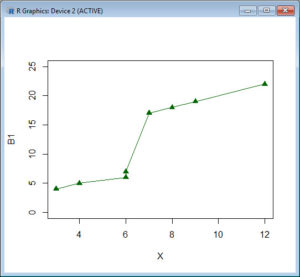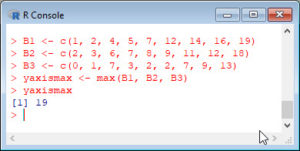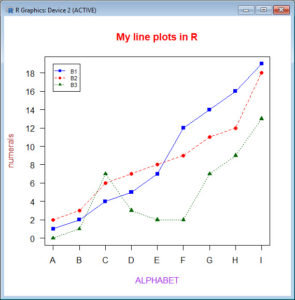In Part 7, let’s look at further plotting in R. Try entering the following three commands to create three variables.
X <- c(3, 4, 6, 6, 7, 8, 9, 12)
B1 <- c(4, 5, 6, 7, 17, 18, 19, 22)
B2 <- c(3, 5, 8, 10, 19, 21, 22, 26)
Graph B1 using a y axis from 0 to 25.
plot(X, B1, type="o", pch = 17, cex=1.2, col="darkgreen", ylim=c(0, 25))

Now superpose a plot of B2.
lines(B2, type="o", pch=16, lty=2, col="blue")

Notice how we plotted the first curve and then added the second using the lines() command. Let’s create a title using the title() command.
title(main="My first R plot", col.main="blue", font.main=2)

You can look up the various arguments for colour and font type on-line. Note the default labels for the horizontal and vertical axes. However, notice that the second curve did not fit into the plot.
Here is another example, in which we automate the calculation of the y-axis limits. Let’s define three vectors.
B1 <- c(1, 2, 4, 5, 7, 12, 14, 16, 19)
B2 <- c(2, 3, 6, 7, 8, 9, 11, 12, 18)
B3 <- c(0, 1, 7, 3, 2, 2, 7, 9, 13)
Calculate the maximum value of B1, B2 and B3.
yaxismax <- max(B1, B2, B3)
yaxismax

We plot on a vertical axis from 0 to yaxismax. Then we disable the default axes and their annotations, using the arguments axes = FALSE, ann=FALSE, so that we can create our own axes. This approach (disabling the default axes) is very important in plotting with R.
plot(B1, pch = 15, type="o", col="blue", ylim=c(0, yaxismax), axes=FALSE, ann=FALSE)
axis(1, at=1:9, lab=c("A","B","C","D","E", "F", "G","H", "I"))

The first argument in the axis command (1) specifies the horizontal axis. The at argument specifies where to place the axis labels. The vector called lab stores the actual labels. Now create a y axis with horizontal labels that display ticks every 2 marks.
axis(2, las=1, at=2*0: yaxismax)

The argument las controls the orientation of the axis labels. Try entering other values. Now create a box around the plot. Then add in the two new curves using the lines() command.
box()
lines(B2, pch = 16, type="o", lty=2, col="red")
lines(B3, pch = 17, type="o", lty=3, col="darkgreen")
Create a title.
title(main="My line plots in R", col.main="red", font.main=2)
Label the x and y axes.
title(xlab=toupper("Alphabet"), col.lab="purple")
title(ylab=tolower("NUMERALS"), col.lab="brown")
Note the toupper command which ensures that text is upper case. The tolower command ensures that text is in lower case.
Create a legend at the location (1, yaxismax).
legend(1, yaxismax, c("B1","B2", "B3"), cex=0.7, col=c("blue", "red", "darkgreen"), pch=c(15, 16, 17), lty=1:3)
The cex argument gives you control over the size of fonts, where the default is 1. You can check out the parameters pch, type and lty for yourselves. You can find these arguments easily on Google by entering R pch, for example. Here is your plot:

That wasn’t so hard! However, you did have to know some syntax and be ready to experiment. In blog 8 we will look at some analytic techniques in R.
Bye for now!
David
Annex: R codes used
# Create three variables.
X <- c(3, 4, 6, 6, 7, 8, 9, 12)
B1 <- c(4, 5, 6, 7, 17, 18, 19, 22)
B2 <- c(3, 5, 8, 10, 19, 21, 22, 26)
# Graph B1 using a y axis from 0 to 25.
plot(X, B1, type="o", pch = 17, cex=1.2, col="darkgreen", ylim=c(0, 25))
# Superpose a plot of B2.
lines(B2, type="o", pch=16, lty=2, col="blue")
# Create a title.
title(main="My first R plot", col.main="blue", font.main=2)
# Create three new variables.
B1 <- c(1, 2, 4, 5, 7, 12, 14, 16, 19)
B2 <- c(2, 3, 6, 7, 8, 9, 11, 12, 18)
B3 <- c(0, 1, 7, 3, 2, 2, 7, 9, 13)
# Calculate the maximum value of B1, B2 and B3 and then display it.
yaxismax <- max(B1, B2, B3)
yaxismax
# Graph B1 using a y axis from 0 to yaxismax.
plot(B1, pch = 15, type="o", col="blue", ylim=c(0, yaxismax),
axes=FALSE, ann=FALSE)
axis(1, at=1:9, lab=c("A","B","C","D","E", "F", "G","H", "I"))
axis(2, las=1, at=2*0: yaxismax)
# Create a box around graph and add lines for B2 and B3.
box()
lines(B2, pch = 16, type="o", lty=2, col="red")
lines(B3, pch = 17, type="o", lty=3, col="darkgreen")
# Create a title.
title(main="My line plots in R", col.main="red", font.main=2)
# Label the x and y axes.
title(xlab=toupper("Alphabet"), col.lab="purple")
title(ylab=tolower("NUMERALS"), col.lab="brown")
# Create a legend at the location (1, yaxismax).
legend(1, yaxismax, c("B1","B2", "B3"), cex=0.7, col=c("blue", "red", "darkgreen"), pch=c(15, 16, 17), lty=1:3)

Senior Academic Manager in New Zealand Institute of Sport and Director of Sigma Statistics and Research Ltd. Author of the book: R Graph Essentials.